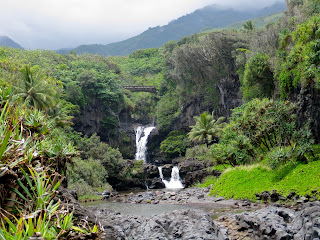I will always choose the Hawaiian islands over the Caribbean. Maybe it's the volcanoes that continue to evolve them, that leave behind such dramatic landscapes. The great distance between the islands and any other land mass helps as well. It is truly a place to go to escape, to relax. The great aviator Charles Lindbergh would agree.
The man who completed the first solo Transatlantic flight in 1927, whose son's kidnapping was sensationalized as the first "Crime of the Century," whose fame placed the world in the palm of his hand, chose the island of Maui to spend his final years. After being diagnosed with lymphoma in 1972, Lindbergh would travel to New York for radiation and chemotherapy. When treatments were no longer effective, he went against his doctors' orders and traveled back to Maui for the last time. His death in 1974 was followed by small, nearly unnoticed funeral procession to the Palapala Ho'omau Church, where his body remains today.
Lindbergh's grave site lies along the Road to Hana, Maui's most scenic drive (and a major tourist draw). Heading east from the airport in Kahului, the road starts out easy, but quickly turns into over 50 miles of steep, narrow, winding pavement with scores of one-land bridges and blind curves. There is no shame in going only 15 mph for this drive. This trip definitely takes all day, and it's best to start out early, as that helps avoid most of the tourist crowds.
There are plenty of places to stop along the road, and they're all beautiful. There are several waterfalls,
black sand beaches,
red sand beaches,
and unbeatable scenic overlooks around every corner.
The traditional "destination" of the Road to Hana is a bit past the city of Hana itself, at O'heo Gulch, part of Haleakala National Park (http://www.nps.gov/hale/) in Kipahulu. Clever marketing by a local hotel proprietor branded this spot the Seven Sacred Pools (there are several pools, but there are not seven, and none of them sacred), and tourists have been flocking ever since. From here, most people backtrack the way they came, while a few others brave the five-mile section of unpaved road and complete the full circle.
One mile west of the Seven Sacred Pools lies the cemetery where Charles Lindbergh is buried. Invisible from the main road, the small churchyard sits quite idyllic on a cliff overlooking the ocean. Taking in the surroundings, I juxtapose the great life he led in the public eye, with how secluded his final resting place is. But one look around makes it clear why he choose this spot. Maui is truly a tropical paradise.
There's one additional anecdote that made this drive truly amazing. Upon returning to Kahului that night, starving and exhausted from the day's trek, the local chain Zippy's was calling my name for exploration. (Also, it was the only thing open that wasn't a national brand). It is a strange combination of diner and fast food, also serving local specialties, Asian dishes, and perfect onion rings. This is the first time in a long time that the onion stayed firmly inside the crispy fried shell after each and every bite. Unlike most incarnations where the onion all falls out and the fried portion remains in your hand, keeping the two parts together is the best way to enjoy this splendid creation. The only thing I forgot to ask for was a side of Ranch dressing.
17 April 2012
Subscribe to:
Comments (Atom)










